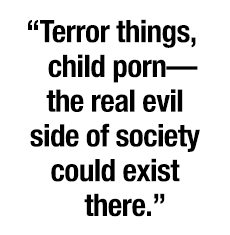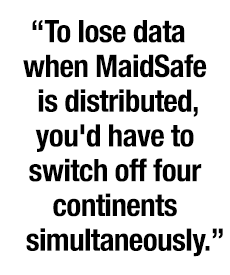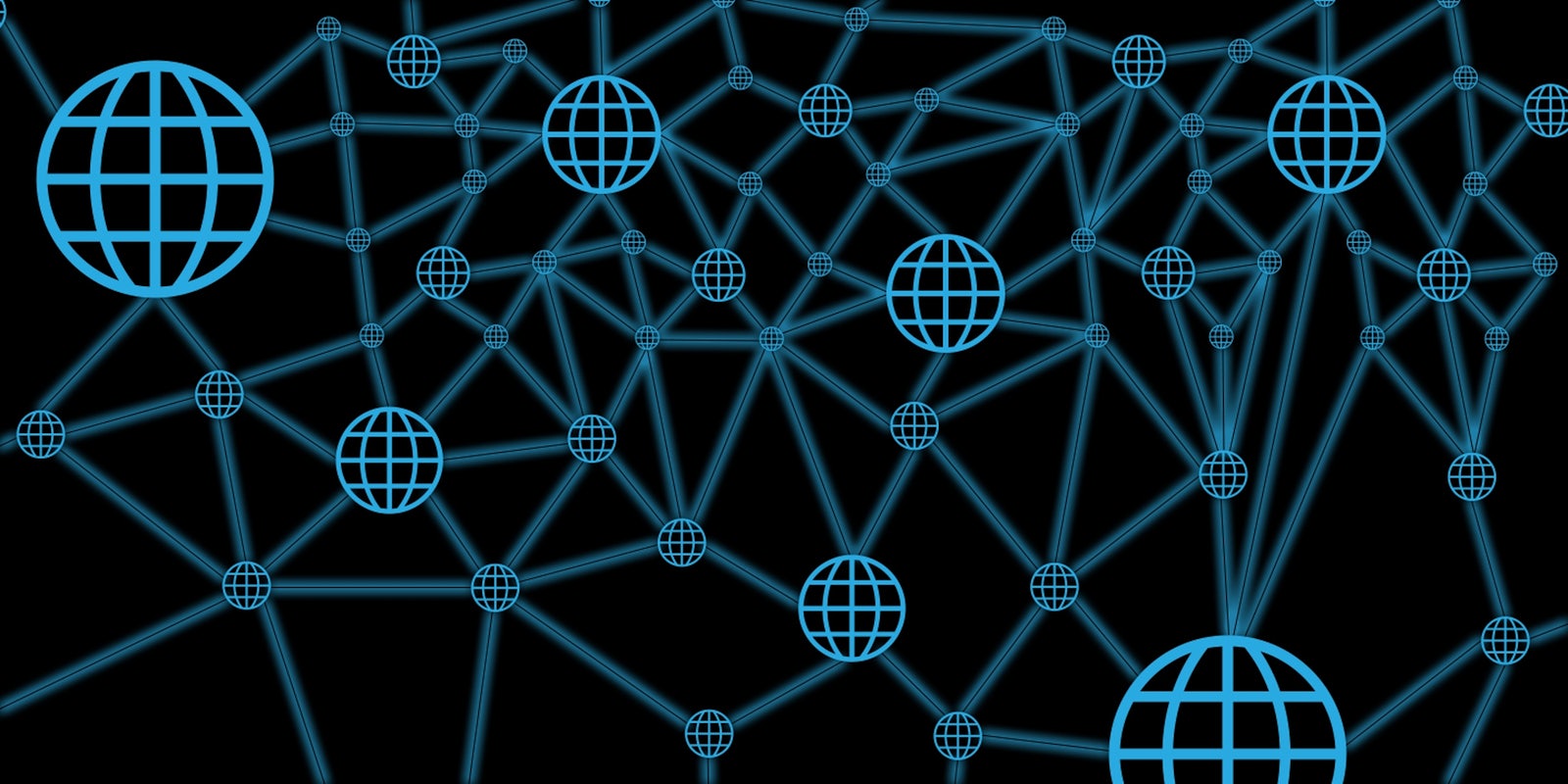The Internet is having a quarter-life crisis.
At just 25 years old, it suffers from two serious problems: Surveillance is carried out en masse, and citizens in many countries can access only the heavily censored or propagandized information available to them.
Those woes have led to a growing chorus calling to decentralize the Internet—to take the power of the Web away from powerful corporations and governments and put it back in the hands of users.
This movement toward a decentralized Internet—to a truly free space, where anyone can communicate privately with anyone else without censorship—does not originate from the White House, Pentagon, or the halls of the United Nations. Instead, as has so often been the case with Internet evolutions, groups of hackers, technologists, and idealists are tucked away in the cracks and shadows, slaving away to make this dream a reality.
One of the people leading the charge towards decentralization is David Irvine, founder of MaidSafe, who created a unique method of securely distributing data in a way that makes it virtually impossible to stop its flow.
The key part of MaidSafe is its Secure Access for Everyone (SAFE) network, which is powered by its participants’ computers. A user’s device—called a “farmer”—dedicates part of its computing power to keep the network running, and part of its hard-drive to store files. Parallels can be drawn with the Tor network, but this time, instead of only donating a portion of your bandwidth—something that SAFE also feeds on—you’re parting with some of your computer’s resources, too.
“In their own right, those farmers are the new Internet platform,” says Irvine.
When a file is stored on the SAFE network, it doesn’t just sit on one person’s computer, waiting to be accessed. Instead, each file has multiple copies, which are divided up into tiny fragments and distributed amongst the network’s farmers. Only the owner of the file has the ability to bring all of these parts together, decrypt the complete file and then view it. If a chunk is deleted—because, say, one of the network’s computers becomes inactive or destroyed—the system autonomously makes additional backups from the remaining copies.
“You would actually have to power off whole routers to try to kill this system,” says Irvine. “To lose data when MaidSafe is distributed, you’d have to switch off four continents simultaneously within about a 20ms time frame to possibly lose a piece of data.”
The SAFE network is the epitome of what is being called the “decentralized Internet.” But as Jean-Philippe Vergne of Western University’s Richard Ivey Business School told me, calling this technology “the Internet” can be misleading, especially when talking about decentralization. To truly understand what a decentralized Internet looks like, he says, we must differentiate between this system’s various layers and how they interact.
At the bottom is the infrastructure—the physical constructions that carry and store data around the planet, such as the fiber-optic cables running underneath the Atlantic, or the servers whirring away storing everything.

Next comes what are called protocols. These are the languages, such as HTTP, that translate the purely physical signals into something a computer can understand. Sitting on top of this is the software that allows human interaction with the system, Web browsers like Firefox or Google Chrome.
The fourth layer is what we users generally think of as “the Internet”: content, such as your favorite blog or a video news report. Finally, the Internet reaches beyond the realm of ones and zeros and enters human discourse. This includes laws, like the Digital Millennium Copyright Act (DMCA)—which makes it illegal to circumvent protections placed on copyrighted content—that dictate how this trifle of technology should or should not be used.
“While the five layers are not completely independent,” Vergne says, “it is possible to have one layer very centralized and another one very decentralized.”
So, while the production of a layer may be decentralized, its control might not be. For example, the content of YouTube is produced largely by independent (decentralized) users uploading whatever they please. However, the company behind the service (Google, in this case) still has the ability to censor or remove anything hosted on its servers. Building an Internet that ditches this type of centralization is anything but easy.
“To provide a completely decentralized Internet services platform, where you’ve got data and structure and communications—basically the platform that the whole Internet can be built upon again—is unbelievably hard,” says Irvine. To get to this beta stage, it has taken the MaidSafe team a total of eight years.
But why does all of this matter? What exactly are decentralized networks capable of, and how does this solve problems such as censorship or surveillance?
One way that governments can shut off access to certain websites is by instructing its Internet service providers (ISPs)—your Verizon, AT&T, or Comcast—to block any traffic trying to make contact with the offending site, or even traffic that looks like it is trying to circumvent censorship, such as that from the Tor network. This should be a much harder feat if the traffic is coming from MaidSafe, according to Irvine.
“We are engineers and unlikely to say impossible, but we think [blocking MaidSafe traffic] will be very difficult and perhaps more difficult than blocking Tor traffic,” he says. “As far as we can reckon today, this will be infeasible for an ISP of firewall to block.”
LIke the Internet we all use now, the key to the SAFE network is not how it works, but the new types of applications it enables.
Imagine a cloud storage or email service that, unlike the dominant players such as Dropbox or Gmail, doesn’t store your data away on a server, vulnerable to both the prying eyes of the hosting company, law enforcement, and intelligence agencies. A decentralized Internet would allow a YouTube-like site, that, because it doesn’t have a central administrator saying what can and what can’t be uploaded, is free to host content that is impossible to censor.
With a decentralized version of Twitter, no accounts could be banned or tweets deleted by the hosting company, and governments cannot cut off access to the service from their country. If this was around during the recent Venezuelan protests, there is no way that the country’s government could have stopped its citizens logging on and sharing information.
It’s important to remember that these applications aren’t actually what MaidSafe is. Instead, they are what can be built on top of it, while taking full advantage of MaidSafe’s decentralized format.
“It’s giving back people control and their security and freedom to speak openly and privately, with who ever they want, and whenever they want,” Irvine says.
Despite this technology only coming about fairly recently, decentralization isn’t actually new. It’s a concept at the heart of many early adopters of the Internet. Attempts at secure communications utilizing it came out of the discussions of the cypherpunks in the 1990s, and a decade later, technologies used to distribute data—such as BitTorrent—took off. Recently, we have had Bitcoin, which—although not fully decentralized (its ledger is a centralized system)—has sent shock waves throughout the tech world because of the power it gives back to users’ finances.

In other words, it’s perhaps more helpful to think of the latest developments as a re-decentralization of the Internet, a trend that is gaining momentum as other programmers leap into developing the next revolutionary bit of tech.
“If MaidSafe doesn’t do it, someone else will,” Irvine says.
That is already the case. DarkMarket, often touted as a decentralized version of the drug bazaar Silk Road, has the potential to distribute data for whistleblowers around the world, or even provide free, secure telephone networks in third-world nations.
Another ambitious project called Outernet aims to beat censorship not by breaking through or burrowing under firewalls, but by firing data over the top of them from satellites. Dispersed elsewhere are myriad developers and programmers working on the protocols that could be used for future decentralization networks.
All of these could help to “include everyone on the planet into a system where they can contribute and they can produce and consume knowledge,” Irvine said.
But all of this freedom and security comes at a cost. Decentralization initiatives, by their very nature, do not favor any one application over another. There is no authority to dictate what should be published and what should not. The network, being autonomous, can be used for any purpose.
That can include jihadi forums, revenge and child pornography sites, or neo-Nazi propaganda. Typically with offending websites, law enforcement find out where the server running it is located and seize it by sending a legal demand to the hosting company. On a decentralized network, such actions become impossible because there is no server to target.
“It’s just not possible,” Irvine says. “Terror things, child porn—the real evil side of society could exist there. They’re going to be completely protected.”
Those campaigning for digital rights, however, think that the trade-off is worthwhile.
“The difference is that the average user will also have the ability to protect themselves from losing information or their privacy,” says Danny O’Brien, international director of the Electronic Frontier Foundation, “and there are far more average users than there are political dissidents or horrible criminals.”
Illustration by Jason Reed


